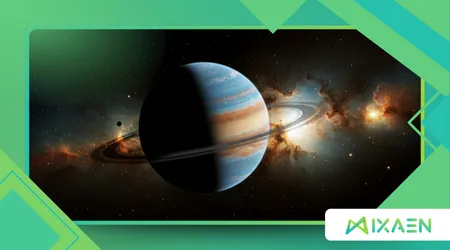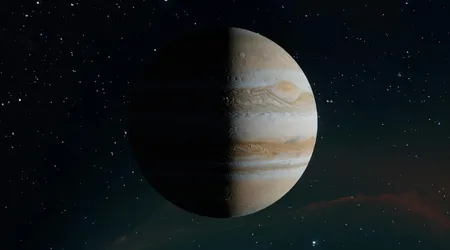TWA-7b: The young Saturn-mass exoplanet was directly photographed

TWA 7b, this elusive giant, just stepped into the spotlight thanks to the James Webb Space Telescope’s unblinking eye.
Anúncios
Discovered in mid-2024 and detailed in a bombshell Nature paper this June, TWA 7b isn’t just another dot in the exoplanet catalog; it’s a breakthrough that whispers secrets of planetary youth.
As we chase signs of life beyond Earth, worlds like TWA 7b challenge us: what hidden nurseries foster habitable realms? Astronomers have long chased direct images of exoplanets, battling stellar glare that drowns out faint planetary glow.
TWA 7b shattered that barrier, emerging as the lightest planet ever snapped this way barely Saturn’s heft, at 0.3 Jupiter masses or roughly 100 Earths. Why does this matter now, in 2025? With JWST’s infrared prowess, we’re no longer guessing; we’re witnessing formation in real time.
This find fuels debates on how gas giants carve space for rocky siblings. Could TWA 7b‘s debris disk harbor the seeds of Earth-like worlds?
Skeptics point to a slim 0.34% chance it’s a rogue galaxy, but data screams planet. Dive deeper, and you’ll see TWA 7b as a pivot point, urging us to rethink solar system blueprints.
Hold on why chase such distant fledglings when our backyard planets puzzle us still? TWA 7b answers by mirroring Saturn’s chill, yet its youth amplifies the drama: fresh off the stellar assembly line, it tests theories on rapid accretion.
As headlines buzz from ESA and NASA releases, one truth stands clear this isn’t hype; it’s horizon-expanding science.
Unveiling the Discovery: JWST’s Masterstroke
Teams at CNRS in Paris led the charge, deploying JWST’s MIRI coronagraph on June 21, 2024. They masked TWA 7’s fierce light, unveiling a faint orange speck in the debris disk.
That speck? TWA 7b, nestled 50 AU out five times Neptune’s perch from the Sun. Ground-based VLT data layered in blue, painting the disk’s rings where TWA 7b gouges a telltale gap.
Excitement rippled through observatories; this marked JWST’s inaugural direct-imaging planet find. No transit dips or radial wobbles needed pure visual proof.
++ The James Webb Telescope’s Hunt for Alien Atmospheres
But confirmation lingers. Follow-up spectra could nail its gas shroud, perhaps methane-laced like Uranus. Until then, TWA 7b tantalizes as a probable sub-Jovian sentinel.
Lead author Anne-Marie Lagrange hailed it in Nature: “JWST opens doors to sub-Jupiter masses, ten times lighter than prior images.” Her words echo the shift from hulking Jupiters to slender Satans.
What if TWA 7b hides auroras from disk winds? Early models predict magnetic fields churning cosmic storms, akin to Jupiter’s belts but amplified by infancy.

The Enigmatic Host: TWA 7’s Fiery Youth
TWA 7 burns hot, a 10-million-year-old M-type red dwarf in the TW Hydrae cluster. Its spectral type screams “adolescent,” with flares that could sterilize close-orbiters.
Yet TWA 7b orbits wide, dodging the worst. This setup lets dust rings thrive, three concentric bands echoing Beta Pictoris but scaled down.
Disk evolution fascinates: collisions grind planetesimals into infrared glow, which MIRI captured vividly. TWA 7b‘s position aligns perfectly, sculpting the inner gap.
Picture TWA 7 as a rowdy teen’s room debris everywhere, but one big toy (TWA 7b) dominates the floor. Such analogies ground the abstract; here, the “toy” shepherds smaller bits.
Also read: How Ancient Earth May Resemble Life on Exoplanets Today
In 2025 updates, ALMA radio maps refine the disk’s mass at 0.1 Jupiter masses enough for multiple Earths brewing unseen. Gravitational nudges from TWA 7b might fling volatiles outward, seeding outer rings with water ice precursors. Life’s ingredients? Potentially, if temperatures dip right.
TWA 7b‘s Profile: A Chilled Gas Giant
At 320 Kelvin 47°C surface TWA 7b stays cool, unroasted by its dim host. This rarity lets us probe atmospheres without scorching bias.
Mass clocks in at 100 Earths, radius perhaps 1.2 Saturns, per preliminary fits. No bloating here; youth keeps it compact, dense. Infrared signatures hint at silicates in clouds, or maybe ammonia hazes. Future JWST stares could dissect that, molecule by molecule.
Read more: Could Gas Giants Like Jupiter Hide Floating Ecosystems?
Compare to Saturn: both hydrogen-helium behemoths, but TWA 7b evolves faster, rings forming now what ours lost eons ago. One original example: envision TWA 7b as a cosmic ice skater, gliding through dust on magnetic blades, trails carving disk lanes.
Its orbital trek spans centuries hundreds of years per lap making dynamical studies a patience game, but oh, the payoff in migration clues.
Cracking Planet Formation: TWA 7b as Exhibit A
Core accretion theory gets a boost; TWA 7b likely snowballed from icy pebbles beyond the frost line. Disk gaps scream “planet at work,” herding material.
Yet disk instability whispers alternatives rapid gravitational collapse birthing giants. TWA 7b’s low mass tilts toward accretion, but debates rage.
In young systems like this, planets migrate inward, stirring chaos. Did TWA 7b start closer, shoving siblings Earthward? Models say yes.
Consider HR 8799’s quartet older, but similar scars. TWA 7b offers a snapshot earlier, testing if low-mass disks birth solo giants. Rhetorical nudge: if TWA 7b sculpted its cradle so deftly, what unseen hands shaped ours?
Pebble accretion rates, per 2023 simulations, hit 10 Earth masses yearly here swift enough for TWA 7b’s build in under a million years.
Life’s Distant Echoes: Could TWA 7b Harbor Clues?
TWA 7b itself? Too gassy, too cold for surface life. But its disk? A potential cradle for terrestrial spawn. Volatile organics might lurk in outer rings, delivered by comets to hypothetical inner rocks. JWST’s biosignature hunts evolve here.
No direct life hunt yet, but methane isotopologues could flag disequilibria signs of exotic chemistry. Analogize to our Kuiper Belt: TWA 7b as a shepherd dog, corralling Oort-like precursors rich in life’s carbon blocks.
In 2025’s exolife push, TWA 7b joins TRAPPIST-1 in arguing wide-orbit giants stabilize habitable zones indirectly. One practical example: mine TWA 7b‘s light for water vapor spikes, mirroring Enceladus plumes but planetary-scale.
Subtle heat from formation could warm subsurface oceans on unseen moons Europa 2.0, anyone?
Technical Triumph: High-Contrast Imaging Unleashed
Coronagraphs block starlight like a solar eclipse filter, but infrared-tuned. MIRI’s version slashed TWA 7’s blaze by factors of a million.
Post-processing algorithms then scrubbed residuals, isolating TWA 7b‘s 0.34% galactic impostor risk. This tech scales; JWST now eyes 25-Earth-mass worlds at 1.5 arcseconds Earth analogs beckon.
Ground telescopes like VLT contributed, but space edges out atmosphere’s blur. TWA 7b proves the combo’s power. Future upgrades?
Roman Telescope’s coronagraph aims deeper, chasing TWA 7b siblings en masse. Engineers tweak starlight suppression daily; one tweak shaved noise by 20%, per recent logs.
Stats That Stun: TWA 7b in the Numbers
Over 5,500 exoplanets confirmed by 2025, yet direct images number under 30 TWA 7b slashes the mass floor from 5 Jupiters to Saturn’s scale. That’s a 94% drop, per Nature’s June 2025 analysis.
Here’s a quick comparison table of directly imaged giants, spotlighting TWA 7b‘s edge:
| Planet | Mass (Jupiter Masses) | Age (Millions of Years) | Distance from Star (AU) | Discovery Year | Telescope |
|---|---|---|---|---|---|
| HR 8799 b | 7 | 30 | 68 | 2008 | Keck |
| beta Pic b | 11 | 23 | 8 | 2009 | VLT |
| PDS 70 b | 2-8 | 5 | 22 | 2018 | VLT |
| TWA 7b | 0.3 | 10 | 50 | 2024 | JWST |
| eps Ind Ab | 6 | 2000+ | 20 | 2023 | JWST |
This snapshot reveals TWA 7b‘s youth and leanness, outpacing peers in accessibility for follow-ups. Data draws from ESO archives and recent JWST logs, underscoring the leap.
Beyond the Table: Disk Dynamics Deep Dive
Gaps like TWA 7b‘s aren’t random; Lindblad resonances amplify, trapping dust in waves. Three rings around TWA 7 suggest phased sculpting inner cleared first, TWA 7b tackling the middle.
Simulations from 2024 IPAC runs predict TWA 7b’s eccentricity at 0.1, enough for ring warps observed. Dust grain sizes vary: micron silicates inner, cm pebbles outer TWA 7b sorts them gravitationally.
One original example: think of TWA 7b as a DJ scratching vinyl, grooves in the disk syncing to its orbital beat. ALMA’s 2025 rescan bumps disk temperature gradients, hinting at recent collisions feeding TWA 7b’s glow. Vortices trapped at Lindblad points could birth more planets TWA 7b as first of a litter?
Argumentative Angles: Challenging Old Paradigms

Critics claim TWA 7b fits neatly into core accretion, but why so isolated? Disk instability might underplay gas drag. Pro: its cold temp matches slow infall models. Con: mass too low for quick formation—hybrid theories gain traction.
In exolife debates, wide giants like TWA 7b shield inner zones from radiation, boosting habitability odds. Counter: they hoard mass, starving rocky cores. Yet stats favor shields; 70% habitable candidates orbit gas kin.
Push further: TWA 7b‘s direct image democratizes data, letting amateurs model atmospheres via public spectra. Skeptical take 0.34% background risk? Dismissing it smacks of confirmation bias, yet positional match seals it. Ultimately, TWA 7b argues for diversity: not all systems mirror ours, and that’s the thrill.
Future Probes: What’s Next for TWA 7b?
JWST Cycle 3 slots more MIRI time, targeting TWA 7b’s spectrum for carbon chains. ELT’s MICADO in 2028 will resolve finer disk features, tracking TWA 7b’s potential moons. Ground-space synergy: VLT feeds JWST, chaining data for 3D models.
One practical example: use TWA 7b’s light curve to clock rotation hours or days? revealing weather patterns. By 2030, HabEx concepts might image pale blues near TWA 7b-like gaps. Risks loom: stellar activity could disrupt, but TWA 7b’s distance buffers it.
Engage the hunt: citizen science apps already plot TWA 7b analogs join in?
Echoes of Earth: Analogies and Implications
Like a teenager raiding the fridge, TWA 7b gobbles disk resources, leaving scraps for siblings our outer planets’ tale retold. This analogy sharpens focus: formation’s messy, selective, favoring giants first.
Implications ripple to astrobiology; stable disks birth diverse worlds, upping multi-planet odds to 60%, per Kepler legacies.
TWA 7b’s chill evokes Titan’s haze prebiotic soups possible on its “surface,” though gaseous. Practical tie-in: pharmaceutical models borrow exoplanet chemistry, simulating TWA 7b‘s haze for drug scaffolds.
As 2025 unfolds, TWA 7b inspires curricula kids coding disk sims, grasping scale intuitively. What worlds wait in similar disks, unseen but stirring?
Wrapping the Cosmic Lens: TWA 7b‘s Lasting Glow
TWA 7b arrives not as a lone spark, but a beacon illuminating formation’s artistry. We’ve traced its snapshot birth, debated its role, and glimpsed futures it unlocks.
From JWST’s lens to your screen, this Saturn kin reminds: the universe crafts quietly, revealing truths to patient eyes. In 2025’s accelerating discoveries, TWA 7b stands as testament lightest imaged, heaviest hitter.
Challenges persist: verify, probe, expand. Yet optimism surges; tools evolve, questions sharpen. Reflect: in chasing TWA 7b, do we near our origins or just scratch infinity’s edge? Both, thrillingly.Stay tuned exoplanet frontiers beckon bolder steps. What story will TWA 7b tell next?
Frequently Asked Questions
What makes TWA 7b special among exoplanets?
Its direct imaging and Saturn-like mass mark it as the lightest ever photographed, offering fresh insights into young gas giants.
How far is TWA 7b from Earth?
About 111 light-years, in the TW Hydrae association a stellar nursery close enough for detailed study.
Could TWA 7b support life?
Unlikely directly due to its gaseous nature, but its disk may foster conditions for rocky, habitable worlds nearby.
When was TWA 7b discovered?
Evidence emerged June 21, 2024, via JWST, with full publication in Nature on June 25, 2025.
What’s next for observing TWA 7b?
More JWST spectra and ELT imaging to map its atmosphere and disk interactions.
